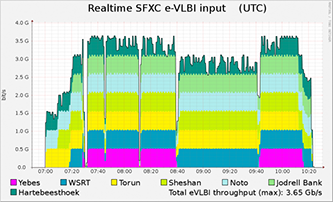Radio-astronomy

Faster, deeper, sharper: revolutionising the world of radio-astronomy
Man has always been fascinated by the stars, making astronomy one of the first sciences to develop. As technology has improved, moving from the naked eye to advanced radio telescopes, so has the ability to see further into the universe. Achieving this level of detail requires unparalleled collaboration between telescopes around the world, often in real-time. In fact, the most detailed picture of the universe is obtained by combining the signals from many radio telescopes scattered across the face of the earth. This technique, called VLBI, or Very Long Baseline Interferometry, can achieve resolutions one thousand times better than that of the Hubble Space Telescope. With these astronomical observations creating huge amounts of data that needs to be shared quickly, high-speed network connections, such as GÉANT and ORIENTplus, are critical to building a more comprehensive and detailed view of our universe.
eVLB and ORIENTplus: building the world’s largest telescope
VLBI is applied for high-resolution imaging of distant radio sources in the universe, such as quasars and black holes, and for making accurate measurements of the motion of the earth in space. Multiple radio telescopes – hundreds and thousands of kilometres apart – are used simultaneously in a powerful array to observe the same region of sky. Data from each telescope is then correlated centrally, simulating a single, giant telescope.
Traditionally, VLBI antennas recorded data onto tapes or disks which were then shipped to a central processing site for correlation analysis. This time-consuming process meant that real-time results were impossible to obtain, a particular problem given the short-lived nature of many astronomical events, such as supernovae and other stellar outbursts.
Advanced data-communications networks, such as GÉANT and ORIENTplus, are now making the real-time, electronic transmission of VLBI data (“e-VLBI”) a reality. This network-based approach enables scientists to have immediate access to data (rather than having to wait for several months), even while experiments are in progress. Immediate analysis of data will even allow them to reposition the telescopes in real-time.
One of the driving forces behind the successful use of e-VLBI is the Joint Institute for VLBI in Europe (JIVE). Based in the Netherlands, it coordinates major astronomical projects and is an integral part of the European VLBI Network (EVN), a collaboration of radio astronomical institutes in Europe and other parts of the world, involving 19 telescopes across 13 countries, including China.
Live demonstration
Participation of Chinese telescopes in joint EVN observations is particularly significant, since the longest baselines (separation between telescopes) result in the highest image resolution. During a live demonstration at the ORIENTplus Launch event in April 2013, JIVE/EVN showcased how the increased link capacity of ORIENTplus allowed seamless data transfer from the Sheshan radio telescope, just outside Shanghai, to Europe, thus acting as a mega-telescope of 10,000 km in width – nearly as big as the face of the earth!
The 25-meter Sheshan radio antenna, operated by EVN member Shanghai Astronomical Observatory, streamed data at 512 Mbps via ORIENTplus to the central facility at JIVE in the Netherlands, for real-time correlation and processing with data sent simultaneously from EVN telescopes across Europe and South Africa. Prior to the upgrade of the link from 2.5 to 10 Gbps, Sheshan participated in joint e-EVN observations via a light path crossing Canada and the Atlantic Ocean. Offering the highest capacity connection and shortest network path between China and Europe, ORIENTplus can now efficiently and effectively carry out this role, significantly reducing latency.
Read the full version of the case study – English version (PDF) *
Read the full version of the case study – Chinese version (PDF)
*Produced in 2012 during the ORIENTplus project.

At the ORIENTplus launch event in April 2013, the Chinese radio telescope at Sheshan observed radio source 0234+285 with radio telescopes at Jodrell Bank (UK), Hartebeesthoek (ZA), Noto (IT), Torun (PL), Westerbork (NL), and Yebes (ES)

